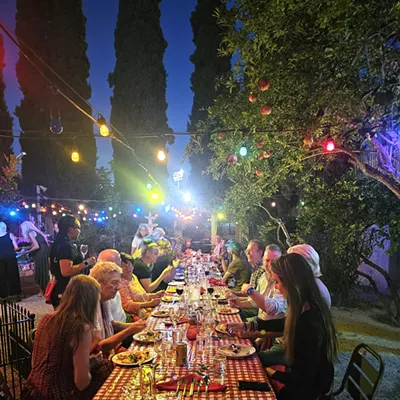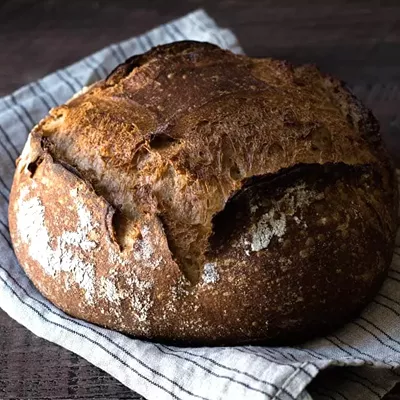If making wine is a science, then Southern Arizona is a superior laboratory. But ditch the lab coats and goggles because the most important components for growing grapes are elevation, climate and soil.
Arizona has more than 80 licensed and bonded wineries, according to the Arizona Wine Growers Association. In Southern Arizona the vineyards are clustered around Sonoita and Willcox. These vineyards don't thrive among saguaros and cholla but in well-watered grasslands above 4,000 feet, where the days are warm and the nights cool.
In 2007, Peggy Fiandaca and Curt Dunham established Lawrence Dunham Vineyards, 36 miles southeast of Willcox. The name honors Dunham's parents—Betty Jane Lawrence and Robert Ervin Dunham.
The winery sits on the western slopes of the Chiricahua Mountains. "This area has incredible soil and water qualities, and the weather, on the edge of briskness, provides a wonderful place to grow mountain fruit," Dunham said.
"Great wine starts in the vineyard," Fiandaca added.
Grapes are traditionally grown along coasts or in valleys below 1,000 feet. Compared with most vineyards, Lawrence Dunham Vineyards sits at a high elevation—4,896 feet. The temperature dips into the 50s at night and rises into the 90s during the day in the growing season. "Plants would rather have it 72 and sunny every day," Dunham said, but that wouldn't make tasty grapes.
These temperature swings stress the grapes, which is a good thing. A stressed grape means a thick skin, which results in better-tasting wine.
But here's where it gets tricky. Like humans, grapes can be too stressed.
"Grapes are an arid plant, meaning they don't want wet feet," Dunham said. When it rains hard during the summer monsoons, the grapes need good drainage.
The grassland soils provide an ideal rain-filtering system. The soils are made of rhyolite, ash and granite. The rhyolite and ash formed from a massive volcanic eruption about 27 million years ago that cooled atop older granite and formed the Chiricahuas. This porous mixture allows rainwater to drip through so the grapes are not sitting in an underground bathtub.
At the same time, this particular mixture of rock helps hold onto a bit of the moisture so the plants don't dry up.
Soils play an important role in determining a wine's taste. They add distinctive flavors to the grapes because the roots pick up minerals and other nutrients that filter downward from the surface. "Grasslands are amazing at storing and accumulating nutrient-rich organic matter in the surface soils," said Rebecca Lybrand, a doctoral student studying soils in the UA's Department of Soil, Water and Environmental Science.
Fiandaca and Dunham modeled their wine varieties after those in the Rhône Valley of southern France, where rocky soils also predominate.
Each year Lawrence Dunham Vineyards produces about 2,000 cases of four varietals: grenache, syrah, petite sirah and viognier. Varietals are wines made from the same type of grape. The opposite of varietals are blends, which are mixtures of varietals.
Petite sirah grapes produce red wine with a spicy, plummy flavor. Syrah, not to be confused with petite sirah, is also a red. It contains flavors of blackberry, mint and black pepper. The third red, grenache, is spicy, with red fruit flavors. It is the dominant variety produced in the Rhône Valley. Grenache grapes thrive in warm, dry conditions. So do viognier grapes, which produce a white varietal with floral aromas and hints of peach, pear and violet.
Elevation, climate and soil all affect the quality of the grapes. So which one matters most?
Stephan Hlohowskyj, a soil scientist and lab manager in UA's Department of Geosciences, offered an interesting analogy. "Let's say you're having a baby and you ask your doctor, 'What is the most dominant factor in the way my baby will look?' There is no one dominant thing because there are 23 chromosomes from each parent that go into making your baby. And that's kind of the same thing when you're growing plants. That's why it's so hard to grow good wine grapes."
Keep in mind that we haven't even gotten to talking about fermenting the grapes and bottling the wine.
After the grape vines are planted, there is a lot of plant-sitting to do. One of the most important tools that Fiandaca and Dunham rely on is a weather station, which tracks the wind flow, humidity, temperature and soil moisture.
Dunham listed the weather variables encountered during one growing season, which is equivalent to one calendar year.
• Ninety-degree heat waves start in May. Hopefully, the plants won't dry out or die of thirst.
• During the summer, thunderstorms and hail can obliterate the plants by ripping their roots out of the ground and damaging leaves and fruit. Also, if the field stays wet for a long time, the grapes can rot.
• Early freezes begin in fall, followed by hard freezes in winter. If frost occurs in spring after the plants have budded, fruit won't form.
• Pests and diseases can also interfere with plant growth.
With 40 acres to tend, Fiandaca and Durham can't just wrap a blanket around their vines to protect them. "There really is not much you can do to prevent the acreage from damage," Fiandaca said, "so we just drink."






